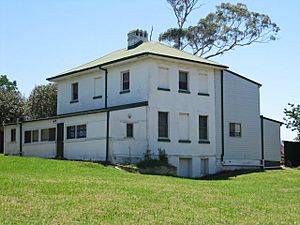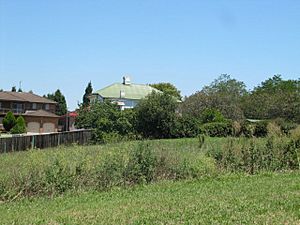Bonnyrigg House facts for kids
Quick facts for kids Bonnyrigg House |
|
|---|---|
 |
|
| Location | Cartwright Street, Bonnyrigg, City of Fairfield, New South Wales, Australia |
| Built | 1825–1826 |
| Architect | possibly Francis Greenway |
| Owner | Office of Environment and Heritage |
| Official name: Bonnyrigg House; Male Orphan School; The Homestead; Schoolmaster's residence | |
| Type | State heritage (complex / group) |
| Designated | 2 April 1999 |
| Reference no. | 281 |
| Type | Homestead Complex |
| Category | Farming and Grazing |
| Builders | A. Kinghorne and Thomas Moore |
| Lua error in Module:Location_map at line 420: attempt to index field 'wikibase' (a nil value). | |
Bonnyrigg House is a very old and important building in Bonnyrigg, Australia. It was built between 1825 and 1826. It is thought that a famous architect named Francis Greenway might have designed it. This house is special because it was once the home for the headmaster of the Male Orphan School. Today, it is protected as a heritage site.
Contents
Bonnyrigg House: A Historic Home
Bonnyrigg House is one of the oldest buildings in the City of Fairfield. It tells an important story about how children were cared for long ago. It also shows how farming and education were linked in early Australia.
Early Days: The Orphan School
In the early 1800s, there were many children in the colony who needed care. These were often children who had lost their parents. Schools were set up to help them.
A New Home for Boys
In 1804, Governor King set aside a large piece of land for a school for girls. This land was rented out to help pay for the school. Later, a school for boys was opened in Sydney. But it needed a bigger, better place.
In 1823, Governor Brisbane decided that the land in Bonnyrigg should be used for a new boys' school. This school would also be a farm. The idea was to teach the boys farming skills. This would help them learn a trade and also grow their own food. This new school was called the "New Farm" near Liverpool.
Farming and Learning
The boys moved to the new farm in 1824. A man named James Busby became the farm manager. He taught the boys how to grow grapes for wine. He planted a vineyard there in 1825. This was a very early step in Australia's wine industry. Wine made from these grapes was even sent overseas in 1831! Busby also wrote a book about growing grapes. He brought many different types of grapevines to Australia.
Bonnyrigg House was built in 1826. It was the home for the school's headmaster. The school complex was quite large. It had dormitories, dining rooms, classrooms, and even a hospital. Most of these buildings were near Bonnyrigg House. The headmasters, like William Walker and Richard Sadlier, lived in the house. The top floor was sometimes used as a courtroom for judges.
The school closed in 1850. The buildings were empty for many years and started to fall apart. The land around the house was rented out to local families.
A Family Home
Later, in the late 1800s, the land was sold off. A large part was bought by William Simpson. He became a very successful farmer in the area. His family lived in Bonnyrigg House for many years. They continued farming grapes and other crops.
Over time, more changes happened to the house. In the early 1900s, parts were added to the front and back of the building. The area around the house also changed. It went from being farmland to a suburban area with many houses.
The House Itself
Bonnyrigg House is a two-storey building. It is made of sandstock brick, which is a type of brick made by hand. It has a hipped iron roof. The windows are old-fashioned double-hung sash windows. They have sandstone blocks above them. Inside, you can see beautiful wooden details and a cedar staircase.
What Bonnyrigg House Looks Like
The house has changed over the years. The original part is the two-storey brick section. It was built in 1826. Later, in the early 1900s, a two-storey wooden extension was added to the back. A single-storey section was also added to the front.
What Else Was There?
When it was an orphan school, there were many other buildings. These included dormitories where the boys slept. There was also a bore, which is a deep hole dug for water. This bore was likely dug by James Busby to find water for the farm. Other signs of the old school, like brick paths and paving, have been found.
Today, the house is surrounded by other homes. But some old plants, like jasmine and oleanders, still grow there. A very tall Bunya Bunya pine tree used to stand near the house, but it was removed in 2003.
Why Bonnyrigg House is Special
Bonnyrigg House is very important to Australia's history. It is listed on the New South Wales State Heritage Register. This means it is protected because of its special value.
Oldest Building in Fairfield
It is believed to be the oldest standing building in the City of Fairfield. This makes it a rare example of early Australian architecture. It shows us what buildings looked like in the 1820s.
A Link to Early Welfare
The house has strong ties to the Male Orphan School. This school was one of the first places in Australia to combine welfare and training for children. It helped shape how social care developed in the country. Many important people from early colonial times were involved with the school, like Samuel Marsden and Governor Macquarie.
Architectural Significance
Bonnyrigg House is a rare example of Colonial Georgian architecture. It is thought to be one of only a few houses designed by the famous architect Francis Greenway that are still standing. It is also the only complete building designed by Alexander Kinghorne, who was a civil engineer.
Connection to Wine History
The site is also important because of its connection to James Busby. He was a pioneer of the Australian wine industry. He taught the boys at the Orphan School how to grow grapes. His work helped start the wine industry we know today.
What We Can Still Learn
Even today, Bonnyrigg House and the land around it can teach us more. There might be old remains hidden underground from the orphanage period. These could give us clues about what life was like for the boys and staff. It helps us understand the history of the area and how people lived long ago.
Bonnyrigg House is a valuable part of New South Wales' history. It shows us about early settlement, farming, and how society cared for children in the past.
Images for kids




